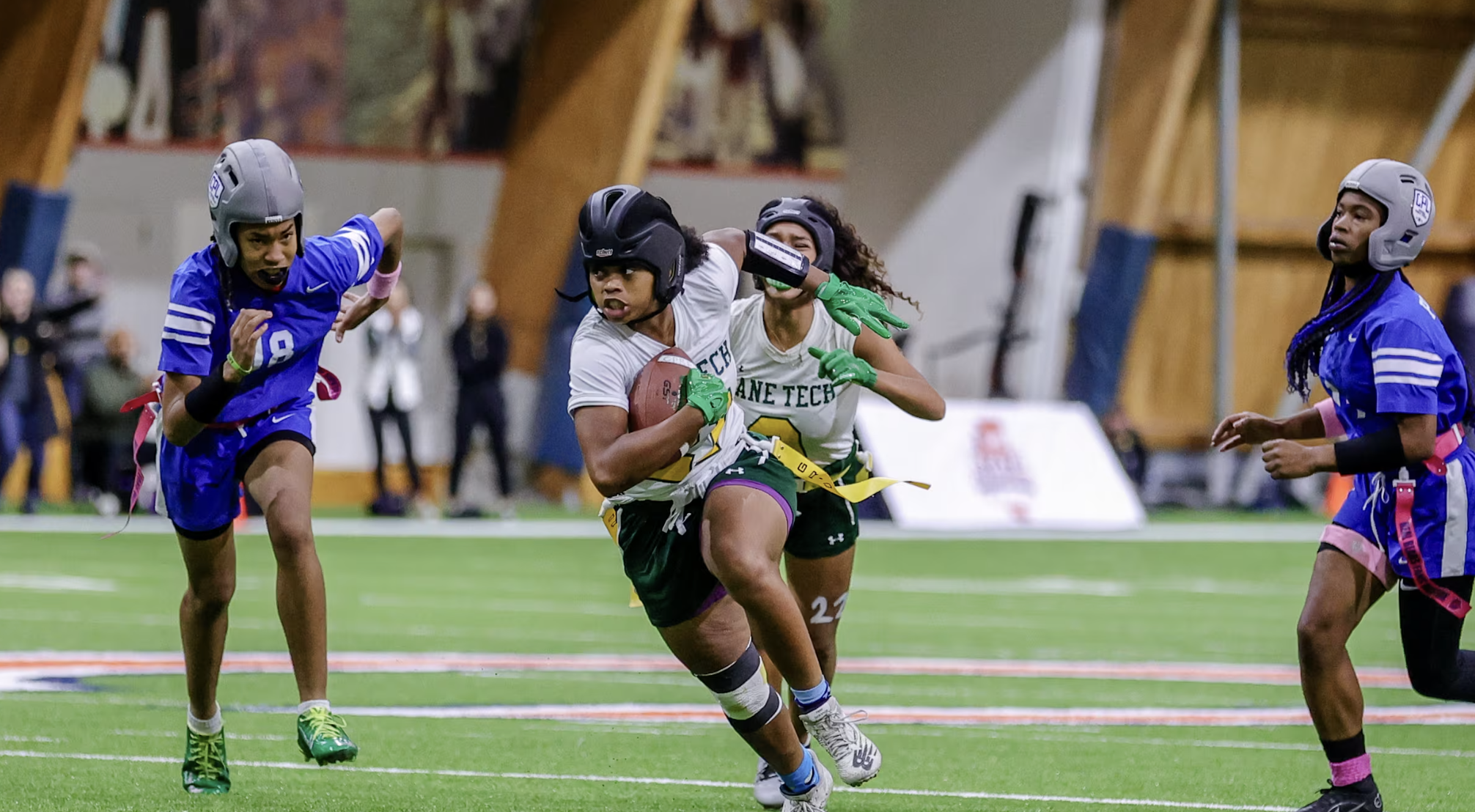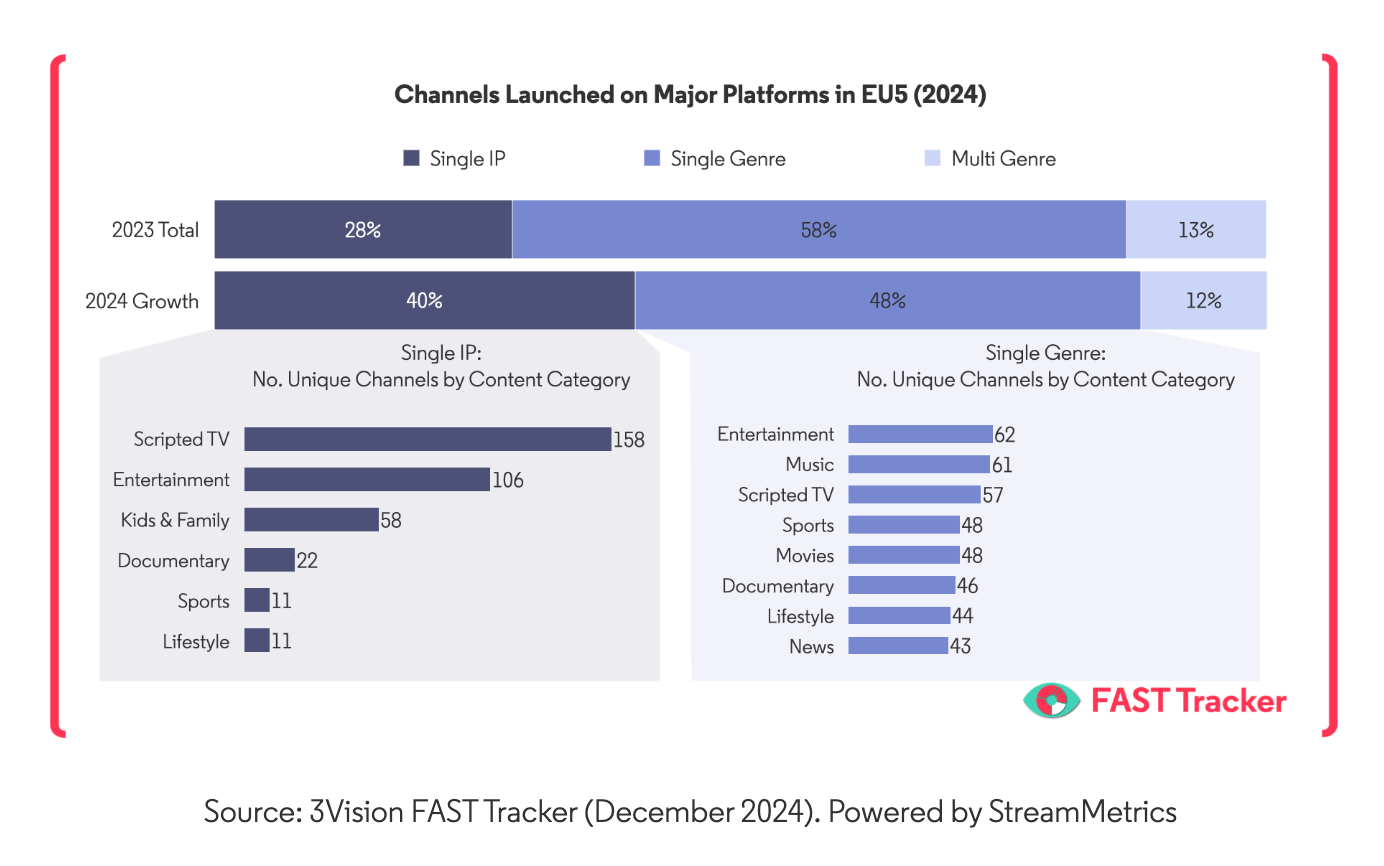
“I did it before it became mainstream!” is still a flex.
But is it relevant for virtual channels? Well, finding the niche that’s actively growing is akin to finding the holy grail for your business.
What is a niche channel? A virtual linear stream focused on a single IP (one show/talent) or a very tight genre, programmed as a 24/7 feed.
In FAST (free ad-supported TV), the flex is the focus. Niche and single-IP channels win because they promise one thing and deliver it every minute. Think Friends, How I Met Your Mother, Hallmark Channel movies, or a Jamie Oliver feed: guaranteed vibe, zero guesswork.
TL;DR
Do niche channels grow? Yes, that's the niche channel phenomenon
Roughly a third of FAST today is single-IP or niche verticals (think Top Gear, Unsolved Mysteries, Yu-Gi-Oh!, Hell’s Kitchen). The same is true for the EU: nearly 40% of launched FAST channels are niche channels that are growing faster than single-genre and mixed-genre channels, despite having fewer content categories (3Vision, 2024).

Why? A clear promise is easy to discover, schedule, package, and sell.
So what’s the secret sauce for a successful niche channel?
Let’s look.
How do I launch a niche FAST channel in 4 steps?
To whip up a niche magic potion, you need some ingredients.
1. Simplify the promise
One sentence can say everything. Cook with Jamie Oliver. Explore the best cars with Top Gear. Discover the next Paul Mescal while watching Gaelic football. It has to be something short and easy to understand.
2. Investigate the market
Spot what becomes “the new black.”
Sure, compared to the National Football League (NFL), the status of flag football is like a fifth-string special teams squad. But since it was approved as an Olympic sport starting in 2028, creating a niche flag football channel now might be a smart move.
Major franchises are investing in flag football teams, so there’s some sense in doing this. Even American football’s GOAT, Tom Brady, is slated to play in a flag football tournament in Saudi Arabia, with other retired NFL pros, in 2026.
3. Prep metadata, ad markers, renditions
Prepping content for streaming means ensuring clean metadata, correct ad markers, reliable renditions, device coverage, and up-to-date standards. Hygiene = discoverability + monetization.
4. Ship and iterate
Ship fast, change faster. Adjust the playlist on-the-fly. If a concept underperforms, spin it down and test the next one. Plan ahead for localization and personalized/virtual linear variants and make sure you’ve picked tech that makes this simple.
What kinds of niche channels can I run?
Pick one, ship it, then clone the winners by market or language.
Single-IP comfort
What it is: One show / one talent / one franchise 24/7.
Why it works: Guaranteed vibe, easy promo, existing archive monetization.
Good when: You own or hold rights; there’s evergreen rewatch value.
Watch-outs: Overfamiliarity → rotation fatigue. Freshen with additional content (behind the scenes, best stunts, bloopers, cast stories).
Tight genre vertical
What it is: One micro-genre with rules everyone gets instantly: “Famous Crimes,” “Paranormal Docs,” “’90s Teen Sitcoms.”
Why it works: Transparent promise, opportunities for contextual ads.
Good when: You have a wide variety of content inside a narrow lane.
Watch-outs: Balancing between being too narrow or too broad, not enough content in rotation.
DIY vibe
What it is: Cooking basics, car care, home renovations.
Why it works: Calms people down, can be watched on repeat, sponsor-friendly.
Good when: You can produce short, indexed segments with clean ad breaks.
Watch-outs: Needs rigorous metadata (topic, difficulty) and high refresh cadence.
Niche sports content
What it is: Highlights, explainers, and culture around under-served sports (flag football, Gaelic football, women’s futsal and so on).
Why it works: Cheaper rights, possibilities to buy cheaper content around (explainers, docs, movies) and passionate micro-communities.
Good when: You want to expand to sports content and are ready to experiment and be the first in the growing segment.
Watch-outs: Be clear about rights, don’t imply live rights you don’t have, and keep the “way out” to avoid getting stuck with content that doesn’t generate revenue.
Event-led pop-ups
What it is: Short-run VOD+live channels around an event: transfer window, tournament week, draft, Halloween docs, awards season.
Why it works: Can be a quick win.
Good when: You can theme a library quickly and ride the news cycle.
Watch-outs: Sunset ruthlessly if it doesn’t convert to steady hours.
Language/local clones
What it is: Same vertical, different language or local host wrap.
Why it works: Multiplies distribution, unlocks regional ad sales.
Good when: You can quickly generate subtitles/VO and get local talents on board.
Watch-outs: Rights management, duplication vs localization.
Creator-led linear
What it is: A stable of creators, packaged into a lean-back feed.
Why it works: Work with creators’ fandoms + frequent drops.
Good when: You can secure multi-platform rights and standardize delivery.
Watch-outs: Rights management, work with social media talents may be risky.
Brand-funded verticals
What it is: Sponsor at the core (outdoor gear + survival docs, cookware + kitchen basics, energy drinks + extreme sports).
Why it works: Clear context, predictable marketing budgets, easy bundles.
Good when: You can guarantee ad distribution and measurement of effectiveness.
Watch-outs: Balancing between editorial and sponsored content.
Bottom line: niche wins
Sharp promise, clean packaging, and agile ops can beat big names. Single-IP or focused micro-verticals can become your new revenue stream.
You don’t need expensive rights. Start small, test as pop-ups, then clone and localize the winners.
Have ideas? Reach out to discuss how to make them a reality.
FAQ
1. Do I need live rights to succeed with a sports FAST channel?
No. Shoulder formats (highlights, explainers, skills clinics, studio talk, docs) can drive hours without expensive live rights.
2. What’s the fastest way to test a niche channel idea?
Run a pop-up for 4–6 weeks, tie it to an event or theme, and track viewing hours, fill rate, and retention. Promote winners to full-time.
3. How do I scale a hit niche channel globally?
Clone by language or region with localized art, metadata, and hosts. Keep the vertical’s rules the same and localize the wrapper.
4. What breaks discoverability on FAST?
Vague titles, messy metadata, missing ad markers, and a message that is hard to get.
